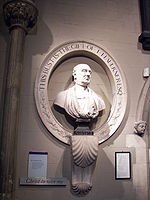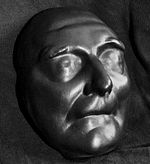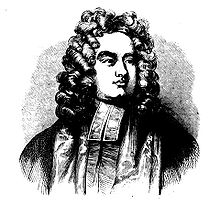- Jonathan Swift
-
Jonathan Swift 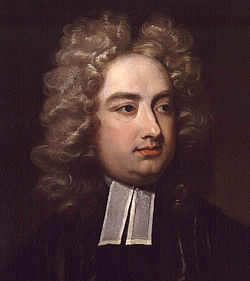
Born 30 November 1667
Dublin, Ireland1Died 19 October 1745 (aged 77)
IrelandPen name M.B. Drapier, Lemuel Gulliver, Isaac Bickerstaff Occupation Satirist, essayist, political pamphleteer, poet, priest Language English Alma mater Trinity College, Dublin Notable work(s) Gulliver's Travels
A Modest Proposal
A Tale of a Tub
Drapier's LettersJonathan Swift (30 November 1667 – 19 October 1745) was an Anglo-Irish[1] satirist, essayist, political pamphleteer (first for the Whigs, then for the Tories), poet and cleric who became Dean of St. Patrick's Cathedral, Dublin.
He is remembered for works such as Gulliver's Travels, A Modest Proposal, A Journal to Stella, Drapier's Letters, The Battle of the Books, An Argument Against Abolishing Christianity, and A Tale of a Tub. Swift is probably the foremost prose satirist in the English language, and is less well known for his poetry. Swift originally published all of his works under pseudonyms—such as Lemuel Gulliver, Isaac Bickerstaff, M.B. Drapier—or anonymously. He is also known for being a master of two styles of satire: the Horatian and Juvenalian styles.
Contents
Biography
Youth
Jonathan Swift was born at No. 7, Hoey's Court, Dublin, the city residence of his uncle and benefactor Godwin Swift (1628-1695), of Swifts Heath House, Co. Kilkenny. He was the second child and only son of Jonathan Swift (1640-1667) and his wife Abigail Erick (or Herrick), of Frisby-on-the-Wreake. His father, a native of Goodrich, Herefordshire, accompanied his brothers to Ireland to seek their fortunes in law after their Royalist father's estate was brought to ruin during the English Civil War. Swift's father died at Dublin before he was born, and his mother returned to England. He was left in the care of his influential uncle, Godwin, a close friend and confidante of Sir John Temple, whose son later employed Swift as his secretary.
Swift's family had several interesting literary connections: His grandmother, Elizabeth (Dryden) Swift, was the niece of Sir Erasmus Dryden, grandfather of the poet John Dryden. The same grandmother's aunt, Katherine (Throckmorton) Dryden, was a first cousin of the wife of Sir Walter Raleigh. His great-great grandmother, Margaret (Godwin) Swift, was the sister of Francis Godwin, author of The Man in the Moone which influenced parts of Swift's Gulliver's Travels. His uncle, Thomas Swift, married a daughter of the poet and playwright Sir William Davenant, a godson of William Shakespeare.
His uncle Godwin took primary responsibility for the young Jonathan, sending him with one of his cousins to Kilkenny College (also attended by the philosopher George Berkeley). In 1682 he attended Dublin University (Trinity College, Dublin), financed by Godwin's son, Willoughby, from where he received his B.A. in 1686, and developed his friendship with William Congreve. Swift was studying for his Master's degree when political troubles in Ireland surrounding the Glorious Revolution forced him to leave for England in 1688, where his mother helped him get a position as secretary and personal assistant of Sir William Temple at Moor Park, Farnham. Temple was an English diplomat who, having arranged the Triple Alliance of 1668, retired from public service to his country estate to tend his gardens and write his memoirs. Gaining the confidence of his employer, Swift "was often trusted with matters of great importance."[cite this quote] Within three years of their acquaintance, Temple had introduced his secretary to William III, and sent him to London to urge the King to consent to a bill for triennial Parliaments.
When Swift took up his residence at Moor Park, he met Esther Johnson, then eight years old, the fatherless daughter of one of the household servants. Swift acted as her tutor and mentor, giving her the nickname "Stella", and the two maintained a close but ambiguous relationship for the rest of Esther's life.
Swift left Temple in 1690 for Ireland because of his health, but returned to Moor Park the following year. The illness, fits of vertigo or giddiness—now known to be Ménière's disease—would continue to plague Swift throughout his life. During this second stay with Temple, Swift received his M.A. from Hertford College, Oxford in 1692. Then, apparently despairing of gaining a better position through Temple's patronage, Swift left Moor Park to become an ordained priest in the Established Church of Ireland and in 1694 he was appointed to the prebend of Kilroot in the Diocese of Connor, with his parish located at Kilroot, near Carrickfergus in County Antrim.
Swift appears to have been miserable in his new position, being isolated in a small, remote community far from the centres of power and influence. While at Kilroot, however, Swift may well have become romantically involved with Jane Waring. A letter from him survives, offering to remain if she would marry him and promising to leave and never return to Ireland if she refused. She presumably refused, because Swift left his post and returned to England and Temple's service at Moor Park in 1696, and he remained there until Temple's death. There he was employed in helping to prepare Temple's memoirs and correspondence for publication. During this time Swift wrote The Battle of the Books, a satire responding to critics of Temple's Essay upon Ancient and Modern Learning (1690). Battle was however not published until 1704.
On 27 January 1699 Temple died. Swift stayed on briefly in England to complete the editing of Temple's memoirs, and perhaps in the hope that recognition of his work might earn him a suitable position in England. However, Swift's work made enemies of some of Temple's family and friends who objected to indiscretions included in the memoirs. His next move was to approach King William directly, based on his imagined connection through Temple and a belief that he had been promised a position. This failed so miserably that he accepted the lesser post of secretary and chaplain to the Earl of Berkeley, one of the Lords Justices of Ireland. However, when he reached Ireland he found that the secretaryship had already been given to another. But he soon obtained the living of Laracor, Agher, and Rathbeggan, and the prebend of Dunlavin in St. Patrick's Cathedral, Dublin.
At Laracor, a mile or two from Trim, County Meath, and twenty miles (32 km) from Dublin, Swift ministered to a congregation of about fifteen people, and had abundant leisure for cultivating his garden, making a canal (after the Dutch fashion of Moor Park), planting willows, and rebuilding the vicarage. As chaplain to Lord Berkeley, he spent much of his time in Dublin and traveled to London frequently over the next ten years. In 1701, Swift published, anonymously, a political pamphlet, A Discourse on the Contests and Dissentions in Athens and Rome.
Writer
In February 1702, Swift received his Doctor of Divinity degree from Trinity College, Dublin. That spring he traveled to England and returned to Ireland in October, accompanied by Esther Johnson—now twenty years old—and his friend Rebecca Dingley, another member of William Temple's household. There is a great mystery and controversy over Swift's relationship with Esther Johnson nicknamed "Stella". Many[who?] hold that they were secretly married in 1716.
During his visits to England in these years Swift published A Tale of a Tub and The Battle of the Books (1704) and began to gain a reputation as a writer. This led to close, lifelong friendships with Alexander Pope, John Gay, and John Arbuthnot, forming the core of the Martinus Scriblerus Club (founded in 1713).
Swift became increasingly active politically in these years. From 1707 to 1709 and again in 1710, Swift was in London, unsuccessfully urging upon the Whig administration of Lord Godolphin the claims of the Irish clergy to the First-Fruits and Twentieths ("Queen Anne's Bounty"), which brought in about £2,500 a year, already granted to their brethren in England. He found the opposition Tory leadership more sympathetic to his cause and Swift was recruited to support their cause as editor of the Examiner when they came to power in 1710. In 1711, Swift published the political pamphlet "The Conduct of the Allies," attacking the Whig government for its inability to end the prolonged war with France. The incoming Tory government conducted secret (and illegal) negotiations with France, resulting in the Treaty of Utrecht (1713) ending the War of the Spanish Succession.
Swift was part of the inner circle of the Tory government, and often acted as mediator between Henry St. John (Viscount Bolingbroke) the secretary of state for foreign affairs (1710–15) and Robert Harley (Earl of Oxford) lord treasurer and prime minister (1711–1714). Swift recorded his experiences and thoughts during this difficult time in a long series of letters to Esther Johnson, later collected and published as The Journal to Stella. The animosity between the two Tory leaders eventually led to the dismissal of Harley in 1714. With the death of Queen Anne and accession of George I that year, the Whigs returned to power and the Tory leaders were tried for treason for conducting secret negotiations with France.
Also during these years in London, Swift became acquainted with the Vanhomrigh family and became involved with one of the daughters, Esther, yet another fatherless young woman and another ambiguous relationship to confuse Swift's biographers. Swift furnished Esther with the nickname "Vanessa" and she features as one of the main characters in his poem Cadenus and Vanessa. The poem and their correspondence suggests that Esther was infatuated with Swift, and that he may have reciprocated her affections, only to regret this and then try to break off the relationship. Esther followed Swift to Ireland in 1714, where there appears to have been a confrontation, possibly involving Esther Johnson. Esther Vanhomrigh died in 1723 at the age of 35. Another lady with whom he had a close but less intense relationship was Anne Long, a toast of the Kit-Cat Club.
Maturity
Before the fall of the Tory government, Swift hoped that his services would be rewarded with a church appointment in England. However, Queen Anne appeared to have taken a dislike to Swift and thwarted these efforts. The best position his friends could secure for him was the Deanery of St. Patrick's, Dublin. With the return of the Whigs, Swift's best move was to leave England and he returned to Ireland in disappointment, a virtual exile, to live "like a rat in a hole".
Once in Ireland, however, Swift began to turn his pamphleteering skills in support of Irish causes, producing some of his most memorable works: Proposal for Universal Use of Irish Manufacture (1720), Drapier's Letters (1724), and A Modest Proposal (1729), earning him the status of an Irish patriot.
Also during these years, he began writing his masterpiece, Travels into Several Remote Nations of the World, in Four Parts, by Lemuel Gulliver, first a surgeon, and then a captain of several ships, better known as Gulliver's Travels. Much of the material reflects his political experiences of the preceding decade. For instance, the episode in which the giant Gulliver puts out the Lilliputian palace fire by urinating on it can be seen as a metaphor for the Tories' illegal peace treaty; having done a good thing in an unfortunate manner. In 1726 he paid a long-deferred visit to London, taking with him the manuscript of Gulliver's Travels. During his visit he stayed with his old friends Alexander Pope, John Arbuthnot and John Gay, who helped him arrange for the anonymous publication of his book. First published in November 1726, it was an immediate hit, with a total of three printings that year and another in early 1727. French, German, and Dutch translations appeared in 1727, and pirated copies were printed in Ireland.
Swift returned to England one more time in 1727 and stayed with Alexander Pope once again. The visit was cut short when Swift received word that Esther Johnson was dying and rushed back home to be with her. On 28 January 1728, Esther Johnson died; Swift had prayed at her bedside, even composing prayers for her comfort. Swift could not bear to be present at the end, but on the night of her death he began to write his The Death of Mrs. Johnson. He was too ill to attend the funeral at St. Patrick's. Many years later, a lock of hair, assumed to be Esther Johnson's, was found in his desk, wrapped in a paper bearing the words, "Only a woman's hair."
Death became a frequent feature in Swift's life from this point. In 1731 he wrote Verses on the Death of Dr. Swift, his own obituary published in 1739. In 1732, his good friend and collaborator John Gay died. In 1735, John Arbuthnot, another friend from his days in London, died. In 1738 Swift began to show signs of illness, and in 1742 he appears to have suffered a stroke, losing the ability to speak and realizing his worst fears of becoming mentally disabled. ("I shall be like that tree," he once said, "I shall die at the top.") To protect him from unscrupulous hangers on, who had begun to prey on the great man, his closest companions had him declared of "unsound mind and memory." However, it was long believed by many that Swift was really insane at this point. In his book Literature and Western Man, author J.B. Priestley even cites the final chapters of Gulliver's Travels as proof of Swift's approaching "insanity".
In part VIII of his series, The Story of Civilization, Will Durant describes the final years of Swift's life as such:
"Definite symptoms of madness appeared in 1738. In 1741 guardians were appointed to take care of his affairs and watch lest in his outbursts of violence he should do himself harm. In 1742 he suffered great pain from the inflammation of his left eye, which swelled to the size of an egg; five attendants had to restrain him from tearing out his eye. He went a whole year without uttering a word."[2]
In 1744, Alexander Pope died. Then, on October 19, 1745, Swift died. After being laid out in public view for the people of Dublin to pay their last respects, he was buried in his own cathedral by Esther Johnson's side, in accordance with his wishes. The bulk of his fortune (twelve thousand pounds) was left to found a hospital for the mentally ill, originally known as St. Patrick’s Hospital for Imbeciles, which opened in 1757, and which still exists as a psychiatric hospital.
Epitaph
- Text extracted from the introduction to The Journal to Stella by George A. Aitken and from other sources)
Jonathan Swift wrote his own epitaph:
- Hic depositum est Corpus
- IONATHAN SWIFT S.T.D.
- Hujus Ecclesiæ Cathedralis
- Decani,
- Ubi sæva Indignatio
- Ulterius
- Cor lacerare nequit,
- Abi Viator
- Et imitare, si poteris,
- Strenuum pro virili
- Libertatis Vindicatorem.
- Obiit 19º Die Mensis Octobris
- A.D. 1745 Anno Ætatis 78º.
The literal translation of which is: "Here is laid the Body of Jonathan Swift, Doctor of Sacred Theology, Dean of this Cathedral Church, where fierce Indignation can no longer injure the Heart. Go forth, Voyager, and copy, if you can, this vigorous (to the best of his ability) Champion of Liberty. He died on the 19th Day of the Month of October, A.D. 1745, in the 78th Year of his Age."
William Butler Yeats poetically translated it from the Latin as:
- Swift has sailed into his rest.
- Savage indignation there
- cannot lacerate his breast.
- Imitate him if you dare,
- world-besotted traveller.
- He served human liberty.
Works
Swift was a prolific writer, notable for his satires. The most recent collection of his prose works (Herbert Davis, ed. Basil Blackwell, 1965-) comprises fourteen volumes. A recent edition of his complete poetry (Pat Rodges, ed. Penguin, 1983) is 953 pages long. One edition of his correspondence (David Woolley, ed. P. Lang, 1999) fills three volumes.
Major prose works
 The title page to Swift's 1735 Works, depicting the author in the Dean's chair, receiving the thanks of Ireland. The Horatian motto reads, Exegi Monumentum Ære perennius, "I have completed a monument more lasting than brass." The 'brass' is a pun, for Wood's half-pence (alloyed with brass) is scattered at his feet. Cherubim award Swift a poet's laurel.
The title page to Swift's 1735 Works, depicting the author in the Dean's chair, receiving the thanks of Ireland. The Horatian motto reads, Exegi Monumentum Ære perennius, "I have completed a monument more lasting than brass." The 'brass' is a pun, for Wood's half-pence (alloyed with brass) is scattered at his feet. Cherubim award Swift a poet's laurel.
Swift's first major prose work, A Tale of a Tub, demonstrates many of the themes and stylistic techniques he would employ in his later work. It is at once wildly playful and funny while being pointed and harshly critical of its targets. In its main thread, the Tale recounts the exploits of three sons, representing the main threads of Christianity, who receive a bequest from their father of a coat each, with the added instructions to make no alterations whatsoever. However, the sons soon find that their coats have fallen out of current fashion, and begin to look for loopholes in their father's will that will let them make the needed alterations. As each finds his own means of getting around their father's admonition, they struggle with each other for power and dominance. Inserted into this story, in alternating chapters, the narrator includes a series of whimsical "digressions" on various subjects.
In 1690, Sir William Temple, Swift's patron, published An Essay upon Ancient and Modern Learning a defense of classical writing (see Quarrel of the Ancients and the Moderns) holding up the Epistles of Phalaris as an example. William Wotton responded to Temple with Reflections upon Ancient and Modern Learning (1694) showing that the Epistles were a later forgery. A response by the supporters of the Ancients was then made by Charles Boyle (later the 4th Earl of Orrery and father of Swift's first biographer). A further retort on the Modern side came from Richard Bentley, one of the pre-eminent scholars of the day, in his essay Dissertation upon the Epistles of Phalaris (1699). However, the final words on the topic belong to Swift in his Battle of the Books (1697, published 1704) in which he makes a humorous defense on behalf of Temple and the cause of the Ancients.
In 1708, a cobbler named John Partridge published a popular almanac of astrological predictions. Because Partridge falsely determined the deaths of several church officials, Swift attacked Partridge in Predictions For The Ensuing Year by Isaac Bickerstaff, a parody predicting that Partridge would die on March 29. Swift followed up with a pamphlet issued on March 30 claiming that Partridge had in fact died, which was widely believed despite Partridge's statements to the contrary. According to other sources,[citation needed] Richard Steele uses the personae of Isaac Bickerstaff and was the one who wrote about the "death" of John Partridge and published it in The Spectator, not Jonathan Swift.*
Drapier's Letters (1724) was a series of pamphlets against the monopoly granted by the English government to William Wood to provide the Irish with copper coinage. It was widely believed that Wood would need to flood Ireland with debased coinage in order make a profit. In these "letters" Swift posed as a shop-keeper—a draper—in order to criticize the plan. Swift's writing was so effective in undermining opinion in the project that a reward was offered by the government to anyone disclosing the true identity of the author. Though hardly a secret (on returning to Dublin after one of his trips to England, Swift was greeted with a banner, "Welcome Home, Drapier") no one turned Swift in. The government eventually resorted to hiring none other than Sir Isaac Newton to certify the soundness of Wood's coinage to counter Swift's accusations. In "Verses on the Death of Dr. Swift" (1739) Swift recalled this as one of his best achievements.
Gulliver's Travels, a large portion of which Swift wrote at Woodbrook House in County Laois, was published in 1726. It is regarded as his masterpiece. As with his other writings, the Travels was published under a pseudonym, the fictional Lemuel Gulliver, a ship's surgeon and later a sea captain. Some of the correspondence between printer Benj. Motte and Gulliver's also-fictional cousin negotiating the book's publication has survived. Though it has often been mistakenly thought of and published in bowdlerized form as a children's book, it is a great and sophisticated satire of human nature based on Swift's experience of his times. Gulliver's Travels is an anatomy of human nature, a sardonic looking-glass, often criticized for its apparent misanthropy. It asks its readers to refute it, to deny that it has adequately characterized human nature and society. Each of the four books—recounting four voyages to mostly-fictional exotic lands—has a different theme, but all are attempts to deflate human pride. Critics hail the work as a satiric reflection on the shortcomings of Enlightenment thought.
In 1729, Swift published A Modest Proposal for Preventing the Children of Poor People in Ireland Being a Burden on Their Parents or Country, and for Making Them Beneficial to the Publick, a satire in which the narrator, with intentionally grotesque logic, recommends that Ireland's poor escape their poverty by selling their children as food to the rich: ”I have been assured by a very knowing American of my acquaintance in London, that a young healthy child well nursed is at a year old a most delicious nourishing and wholesome food...” Following the satirical form, he introduces the reforms he is actually suggesting by deriding them:
Therefore let no man talk to me of other expedients...taxing our absentees...using [nothing] except what is of our own growth and manufacture...rejecting...foreign luxury...introducing a vein of parsimony, prudence and temperance...learning to love our country...quitting our animosities and factions...teaching landlords to have at least one degree of mercy towards their tenants....Therefore I repeat, let no man talk to me of these and the like expedients, 'till he hath at least some glympse of hope, that there will ever be some hearty and sincere attempt to put them into practice.
Essays, tracts, pamphlets, periodicals

- "A Meditation upon a Broomstick" (1703–1710): Full text: munseys.com
- "A Critical Essay upon the Faculties of the Mind" (1707–1711)
- The Bickerstaff-Partridge Papers (1708–1709): Full text: U of Adelaide
- "An Argument Against Abolishing Christianity" (1708–1711): Full text: U of Adelaide
- The Intelligencer (with Thomas Sheridan) (1719–1788): Text: Project Gutenberg
- The Examiner (1710): Texts: Ourcivilisation.com, Project Gutenberg
- "A Proposal for Correcting, Improving and Ascertaining the English Tongue" (1712): Full texts: Jack Lynch, U of Virginia
- "On the Conduct of the Allies" (1713)
- "Hints Toward an Essay on Conversation" (1713): Full text: Bartleby.com
- "A Letter to a Young Gentleman, Lately Entered into Holy Orders" (1720)
- "A Letter of Advice to a Young Poet" (1721): Full text: Bartleby.com
- Drapier's Letters (1724, 1725): Full text: Project Gutenberg
- "Bon Mots de Stella" (1726): a curiously irrelevant appendix to "Gulliver's Travels"
- "A Modest Proposal", perhaps the most notable satire in English, suggesting that the Irish should engage in cannibalism. (Written in 1729)
- "An Essay on the Fates of Clergymen": Full text: JaffeBros
- "A Treatise on Good Manners and Good Breeding": Full text: Bartleby.com
Poems
- "Ode to the Athenian Society", Swift's first publication, printed in The Athenian Mercury in the supplement of Feb 14, 1691.
- Poems of Jonathan Swift, D.D. Texts at Project Gutenberg: Volume One, Volume Two
- "Baucis and Philemon" (1706–1709): Full text: Munseys
- "A Description of the Morning" (1709): Full annotated text: U of Toronto; Another text: U of Virginia
- "A Description of a City Shower" (1710): Full text: U of Virginia
- "Cadenus and Vanessa" (1713): Full text: Munseys
- "Phillis, or, the Progress of Love" (1719): Full text: theotherpages.org
- Stella's birthday poems:
- 1719. Full annotated text: U of Toronto
- 1720. Full text: U of Virginia
- 1727. Full text: U of Toronto
- "The Progress of Beauty" (1719–1720): Full text: OurCivilisation.com
- "The Progress of Poetry" (1720): Full text: theotherpages.org
- "A Satirical Elegy on the Death of a Late Famous General" (1722): Full text: U of Toronto
- "To Quilca, a Country House not in Good Repair" (1725): Full text: U of Toronto
- "Advice to the Grub Street Verse-writers" (1726): Full text: U of Toronto
- "The Furniture of a Woman's Mind" (1727)
- "On a Very Old Glass" (1728): Full text: Gosford.co.uk
- "A Pastoral Dialogue" (1729): Full text: Gosford.co.uk
- "The Grand Question debated Whether Hamilton's Bawn should be turned into a Barrack or a Malt House" (1729): Full text: Gosford.co.uk
- "On Stephen Duck, the Thresher and Favourite Poet" (1730): Full text: U of Toronto
- "Death and Daphne" (1730): Full text: OurCivilisation.com
- "The Place of the Damn'd" (1731): Full text
- "A Beautiful Young Nymph Going to Bed" (1731): Full annotated text: Jack Lynch; Another text: U of Virginia
- "Strephon and Chloe" (1731): Full annotated text: Jack Lynch; Another text: U of Virginia
- "Helter Skelter" (1731): Full text: OurCivilisation.com
- "Cassinus and Peter: A Tragical Elegy" (1731): Full annotated text: Jack Lynch
- "The Day of Judgment" (1731): Full text
- "Verses on the Death of Dr. Swift, D.S.P.D." (1731–1732): Full annotated texts: Jack Lynch, U of Toronto; Non-annotated text:: U of Virginia
- "An Epistle To A Lady" (1732): Full text: OurCivilisation.com
- "The Beasts' Confession to the Priest" (1732): Full annotated text: U of Toronto
- "The Lady's Dressing Room" (1732): Full annotated text: Jack Lynch
- "On Poetry: A Rhapsody" (1733)
- "The Puppet Show" Full text: Worldwideschool.org
- "The Logicians Refuted" Full text: Worldwideschool.org
Correspondence, personal writings
- "When I Come to Be Old" – Swift's resolutions. (1699): Full text: JaffeBros
- The Journal to Stella (1710–1713): Full text (presented as daily entries): The Journal to Stella; Extracts: OurCivilisation.com;
- Letters:
- Selected Letters: JaffeBros
- To Oxford and Pope: OurCivilisation.com
- 'The Correspondence of Jonathan Swift, D.D'. Edited by David Woolley. In four volumes, plus index volume. Frankfurt am Main ; New York : P. Lang, c1999-c2007.
Sermons, prayers
- Three Sermons and Three Prayers. Full text: U of Adelaide, Project Gutenberg
- Three Sermons: I. on mutual subjection. II. on conscience. III. on the trinity. Text: Project Gutenberg
- Writings on Religion and the Church. Text at Project Gutenberg: Volume One, Volume Two
- "The First He Wrote Oct. 17, 1727." Full text: Worldwideschool.org
- "The Second Prayer Was Written Nov. 6, 1727." Full text: Worldwideschool.org
Miscellany
- Directions to Servants (1731):: Extracts: OurCivilisation.com
- A Complete Collection of Genteel and Ingenious Conversation (1738)
- "Thoughts on Various Subjects." Full text: U of Adelaide
- Historical Writings: Project Gutenberg
- Swift Quotations: JaffeBros – many choice, well-documented Swift quotations here
- Swift quotes at Bartleby: Bartleby.com – 59 quotations, with notes
Legacy
John Ruskin named him as one of the three people in history who were the most influential for him.[3]
Swift crater, an crater on Mars's moon Deimos, is named after Jonathan Swift, who predicted the existence of the moons of Mars.[4]
Notes
- ^ Encyclopaedia Britannica: "Anglo-Irish author, who was the foremost prose satirist in the English language".
- ^ "The Story of Civilization", V.8., 362.
- ^ John Ruskin: Sesame and Lillies
- ^ MathPages - Galileo's Anagrams and the Moons of Mars.
Biographical sources
- Samuel Johnson's "Life of Swift": JaffeBros. From his Lives of the Poets.
- William Makepeace Thackeray's influential vitriolic biography: JaffeBros. From his English Humourists of The Eighteenth Century.
- Bullitt, John M. Jonathan Swift and the Anatomy of Satire: A Study of Satiric Technique, 1953, Cambridge: Harvard U P,
- Jae Num Lee "Swift and Scatological Satire", 1971, University of New Mexico Press, ISBN 0826301967 jstor review
- Lee, Jae Num. "Scatology in Continental Satirical Writings from Aristophanes to Rabelais" and "English Scatological Writings from Skelton to Pope." Swift and Scatological Satire. Albuquerque: U of New Mexico P, 1971. 7–22; 23–53.
- Susan Gubar "The Female Monster in Augustan Satire" Signs, Vol. 3, No. 2 (Winter, 1977), pp. 380–394
- Many other sources are listed here.
See also
External links
 Chisholm, Hugh, ed (1911). "Swift, Jonathan". Encyclopædia Britannica (11th ed.). Cambridge University Press.
Chisholm, Hugh, ed (1911). "Swift, Jonathan". Encyclopædia Britannica (11th ed.). Cambridge University Press.- Free audiobook of A Modest Proposal from LibriVox
- BBC audio file "Swift's A modest Proposal". BBC discussion. In our time.
- Works by or about Jonathan Swift in libraries (WorldCat catalog)
- Jonathan Swift at the Open Directory Project
E-texts of works
Works by Jonathan Swift Satires A Tale of a Tub (1704) · The Battle of the Books (1704) · Gulliver's Travels (1726)
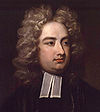
Essays Thoughts on Various Subjects, Moral and Diverting (1706) · An Argument Against Abolishing Christianity (1708) · Drapier's Letters (1724/25) · A Modest Proposal (1729)
Sermons Sermons of Jonathan Swift
Miscellany A Complete Collection of Genteel and Ingenious Conversation (1738) · A Journal to Stella (published posthumously – 1766)
Categories:- 1667 births
- 1745 deaths
- Jonathan Swift
- 18th-century Anglican clergy
- Alumni of Hertford College, Oxford
- People educated at Kilkenny College
- Anglo-Irish artists
- Anglo-Irish people
- Burials at St Patrick's Cathedral, Dublin
- Christian writers
- English Anglicans
- English fantasy writers
- English novelists
- English poets
- English political writers
- English satirists
- Irish fantasy writers
- Irish novelists
- Irish poets
- Irish political writers
- Irish satirists
- Neoclassical writers
- People associated with Trinity College, Dublin
- People from County Dublin
- Church of Ireland deans
Wikimedia Foundation. 2010.

